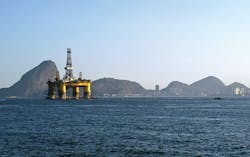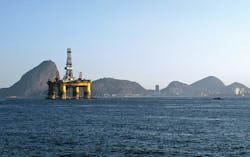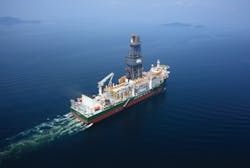Jose Luis Algibez
Luis Batalla
Bipinchandra Dugam
Repsol Sinopec
Brazilian presalt is probably the most promising area worldwide for the oil and gas industry. However, presalt layer operations pose many challenges due to their depth, pressure, and distance from shore.
Repsol has operated the Brazilian presalt block BM-C-33, located in the Campos basin, since 1997. There, the company has made the discoveries of Pão de Açúcar, Seat, and Gávea, which are estimated to hold more than 700 MMbbl of light oil and 3 tcf of gas, representing the biggest discovery ever made by a private company in Brazil. This article will look at the main aspects of the operations carried out in block BM-C-33 through the joint venture Repsol Sinopec Brasil (RSB).
Exploration overview
BM-C-33 is one of the most challenging projects worldwide not only from an operational perspective, but also from a geological and geophysical point of view. Between 2009 and 2012, three wells were drilled in block C-M-539 of the BM-C-33 concession contract in the offshore Campos basin. The wells, located 150 km (93 mi) from the coast, reached total depths of 6,554 m (21,502 ft), 6,819 m (22,371 ft), and 7,121 m (23,362 ft), respectively, with water depths ranging from 2,667 m (8,750 ft) to 2,800 m (9,186 ft). The wells discovered hydrocarbons on the Lagoa Feia Gap from Aptian times. Some of the key features of the area geology are described below.
Presalt structure. The presalt formations in BM-C-33 are geological layers that were laid down before a thick salt layer accumulated above them during the break-up of the super continent "Gondwana."
Seismic imaging. Reservoirs in the basin showed strong stratigraphic control, complex subsalt geometry, and an ultra-deep seafloor. A decision was made to perform the first tilted transverse isotropy (TTI) anisotropic Kirchhoff prestack depth migration (PSDM) project in-house. Anisotropy parameters were interpolated in a structurally consistent manner estimated by minimizing the mistie between the seismic and depth markers in four wells. The dynamic estimation for anisotropic Thomsen parameters was an innovation developed by Repsol Subsurface Imaging group. TTI aims to identify the trend of the depositional systems and incorporates geological information, thus providing a better velocity model and seismic images.
Reservoir uncertainties. Detailed thin sections and microCT scan studies revealed dual porosity systems with microporosity predominance. Samples presented preferential porous regions, eventually interconnected by less porous structures.
Massive mud losses during the drilling of the wells indicated high porosity/permeability cavern systems. In fact, centimeter- to metric -scale caves were confirmed by image logs. The quantification of non-connected vuggy porosity was performed with sonic, nuclear magnetic resonance (NMR), and image data.
Generally, different porosity quantification methods such as raw caliper (RCAL), logs (NMR, neutron-density, sonic), and image are consistent, even though they represent different evaluation scales (micro, meso, and macro).
However, permeability measurements are more variable. The permeability estimations from logs (NMR, Stoneley, modular formation dynamics (MDT)) broadly match, but side wall corings (SWC) present lower permeability values. It suggests that punctual SWC does not represent the real permeability. Moreover, macroscale well testing permeability estimation is much bigger than the log derived permeabilities, indicating contribution of non-tested/logged cave systems.
Many of the remaining uncertainties in facies and reservoir characterization in the area are expected to be addressed by the multidisciplinary team working on this project. This working group consists of petrophycisists, reservoir geologists, geophycisists and interpreters supported by a team of high level sedimentologists and specialists from many other disciplines.
Drilling aspects
From a drilling point of view, block BM-C-33 poses numerous challenges in terms of well designs and drilling operations. The combined complexities of ultra-deepwater drilling and complex reservoir systems demand attention, cutting edge technology, as well as time and financial capital together with the use of existing resources. Below is an overview of the drilling challenges and technology solutions RSB has used and plans to employ in the future.
Ultra-deepwater and deep targets. The water depth in the block ranges from 2,600 m (8,530 ft) to 3,000 m (9,842 ft) and reservoir targets are located as deep as 7,200 m (23,621 ft). This requires the use of the latest generation of drillships to drill at depths of up to 3,000 m, while handling large quantities of drilling fluids as well as heavy and long casing strings which can weigh up to 2 MMlbs. RSB is using an Ocean Rig Mylos drillship, which is among the biggest floating rigs available in the market.
Thick salt sections. The wells are located within a salt layer ranging from 300 m (984 ft) to 3,000 m; hence, it was important to apply the correct drilling fluid density, to keep the salt body open during operations. Up until now, RSB has drilled the thickest salt section of 2,700 m (8,858 ft) in this block. Drilling thick salt sections carries numerous difficulties such as stuck pipes, salt closure, and salt entry and exit. Salt exit is one of the key issues and requires special attention due to the risk of losses at the base of the salt layer.
Directional wells (S-shape). Over time, the seabed has been altered by the salt movement which has created numerous big faults extending up to the seabed as well as big caverns and valleys. This condition limits the ability to drill vertical wells into the reservoir. To date, RSB has successfully drilled an S-shape directional well with a 24° angle inside the salt in order to reach the reservoir. This challenging directional well required extensive planning in terms of geomechanics, salt stability, directional strategy, and tools. This was the first S-shape directional well drilled using power drive with an 18 and 1/8-in. bit and simultaneously under-reaming to 20 in.
Hard and silicified carbonates drilling. The formation is extremely hard (UCS-30-35K) and abrasive due to the silicified nature. This slow drilling challenge requires the application of the latest bit and turbine technology. New bit and downhole tool technology is still under study and field trial.
Well testing. There are several challenges for well testing in ultra-deepwater environments such as deep presalt wells, formation damage, and flow assurance (hydrates). To mitigate these risks, RSB is using the latest technology such as a special subsea test tree system with the ability to cut coil tubing of up to 1.75-in. outside diameter with a disconnection time of 20 seconds; a wireless annular pressure buildup monitoring system for casing annulus; real-time downhole data acquisition system during the entire drillstem test to guide drilling decisions; a high flowrate (10 gpm) subsea monoethylene glycol injection system and lower completions with formation isolation valves.
Setting the building blocks
Brazilian presalt discoveries are not only surrounded by a salt layer which is difficult to see and drill through, but they are also located in ultra-deepwater; a challenging environment for facility development.
To deliver successful projects in such a difficult environment, it is crucial to identify what can be built in order to best satisfy all project requirements. RSB is using the "building blocks approach" for its facilities visualization phase in order to define a broad and clear range of feasible development architectures from which, later on, the best will be selected.
The building blocks approach is a well-known technique for complex problem solving, which consists of finding alternative solutions to subsets of the overall problem, thus narrowing down the potential range of solutions. RSB has adapted this approach by following these processes, grouped into two stages -- qualitative and semi-quantitative.
During the qualitative stage, a range of possible solutions is defined to its broadest extent and then narrowed down. Through a number of brainstorming exercises, the requirements and scope are studied and a list of "building blocks" for the field development is generated. Potential concepts for each of these items are identified and assessed. Once each building block has a set of possible solutions, a portfolio of potential development architectures is defined and ranked by feasibility, commercial, and technical success factors.
At the second stage, with a reduced but considerable number of potential development facilities architectures, capex estimates are generated at class five accuracy, and risks and opportunities are identified for each alternative architecture, providing risk-inclusive estimates which are used to rank the different architectures.
The final semi-quantitative stage combines rankings from the previous steps: expected capex efficiency ratio, and technical and commercial soundness, which produces a unified ranking that is used for selecting the most preferable architectures. This is then passed to concept selection and conceptualization studies.
It is important to note that the aim of this screening methodology is not only to select the highest scoring cases for further progression, but also to develop knowledge of the facts and concepts that drive the accuracy of each alternative.
The authors
Jose Luis Algibez is Exploration Manager, Block BM-C-33, Brazil, for Repsol Sinopec. Algibez joined Repsol in 1995 and has been involved in the company's oil and gas exploration and development business from field geology to wildcat drilling, including oil field development. Jose has lived and worked in Algeria, Bolivia, Libya, the USA, Venezuela, and Brazil where he has managed newly discovered oil fields and assessed them for further development.
Luis Batalla is Facilities Engineering Manager of BM-C-33, Brazil, for Repsol Sinopec. Batalla joined Repsol in 2005 and has been the Facilities Engineering Manager of the BM-C-33 development since 2012. He has over 16 years of experience in oil and gas projects. In addition, Batalla is experienced in all aspects of offshore and onshore surface facilities developments, as well as in refining and petrochemical projects.
Bipinchandra Dugam is an Engineering Manager for Repsol Sinopec in Brazil. He joined Repsol in 2007 and has worked as an Engineering Manager (Drilling & Completions) in Brazil since August 2012. Bipinchandra has over 10 years' experience in drilling engineering, well planning, and testing and directional drilling.





